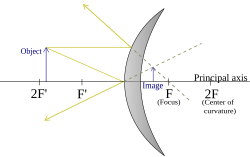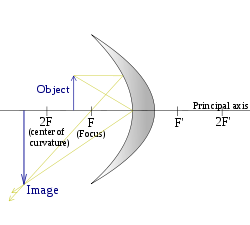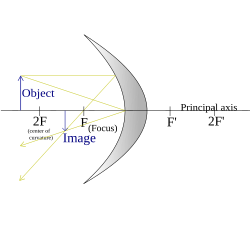Spherical Mirrors:
A spherical mirror is a portion of the reflecting surface of
a hollow sphere.
1.Concave Mirror:
In this mirror,the inner curved
surface is reflecting.
2.Convex Mirrors:
In this mirror,the outer convex
surface is reflecting.
Centre of Curvature:
Aperture:
The front section of spherical mirror
is circular one and its diameter is known as the Aperture.
The Principal Focus:
Rays of light parallel to the principal
axis after reflection from a concave mirror converge to focus on a point say
F.This point is called as principal focus of the concave mirror.
In case of concave mirror,as the
rays of light actually pass through this point,it is called as real focus.
In case of convex mirror,rays
parallel to the principal axis after reflection appear to come from a point F
situated behind the mirror.This point is called the principal focus of the
convex mirror and in case of convex mirror,it is termed virtual focus as the
rays of light donot actually pass through this point.
Focal Length:
The distance between the pole and
principal focus of a spherical mirror is
called The Focal Length of that mirror.
It is denoted by f
f = R/2
Where R represents The Radius Of Curvature.
Linear Magnification:
The ratio of height of image to
height of an object is called as Linear Magnification and is denoted by m
Magnification = m= Image Height/Object Height.
Uses Of Spherical Mirrors:
1.In huge shopping malls,convex mirrors are used for security purposes
as they give a large field of vision.
2.Concave mirrors with parabolic shape are used in search light to throw
an intense beam of light to a large distance.
3.Concave Mirrors are used for
shaving as it gives an enlarged image of the face when someone stand between
the principal focus and pole of the mirror.
4.Giant concave mirrors are also
used in telescopes.
5.Convex mirrors are used in motorcycles
and automobiles that enable the driver to see automobiles coming behind them.
6.Concave mirrors are used in
medical equipment such as by doctors to examine ear,nose and throat of patients
andin microscopes to view slides clearly.
| Object's position (S), focal point (F) | Image | Diagram |
|---|---|---|
 |
|  |

| Object's position (S), focal point (F) | Image | |
|---|---|---|
 (Object between focal point and mirror) |
|

 (Object at focal point) |
|---|

 (Object between focus and centre of curvature) |
|
|---|

 (Object at centre of curvature) |
|
|---|

 (Object beyond centre of curvature) |
|
|---|
No comments:
Post a Comment